23+ Tips for Note Taking to Make Studying & Getting an A Easier
Looking for the best tips for note taking to make studying easier and snag that A+ you’re vying for? I’ve got you covered.
Honestly, learning often starts with mastering the art of taking notes. Picture this: you’re sitting in a lecture hall or cozying up with a textbook, and instead of feeling overwhelmed by the avalanche of information, you feel empowered, organized, and ready to conquer.
That’s the magic of having a solid note-taking strategy.
In this blog post, we’re diving into a treasure trove of advice that’ll transform the way you record and remember information. Whether you’re a freshman just starting out or a seasoned student looking to up your game, these tips for note taking are your ticket to making studying less of a chore and more of a triumph.
Ready to turn note taking from a mundane task into your secret weapon for academic success? Let’s get started!
Best Tips for Note Taking

1. Use Headings and Bullet Points
Organizing notes with clear headings and bullet points is like creating a roadmap for your brain.
Good note taking is really all about making the information easy to navigate. Start by breaking down your notes into main topics – these make for great headings. Think of them as signposts that guide you through the landscape of your notes.
Once you have your headings, you want to use bullet points to list out key ideas, facts, and figures. This method turns a wall of text into a neatly organized list, making it easier to locate specific information later. Not only do you get clearer and more structured notes that are easier to study, visually appealing notes can boost your motivation to work with them.
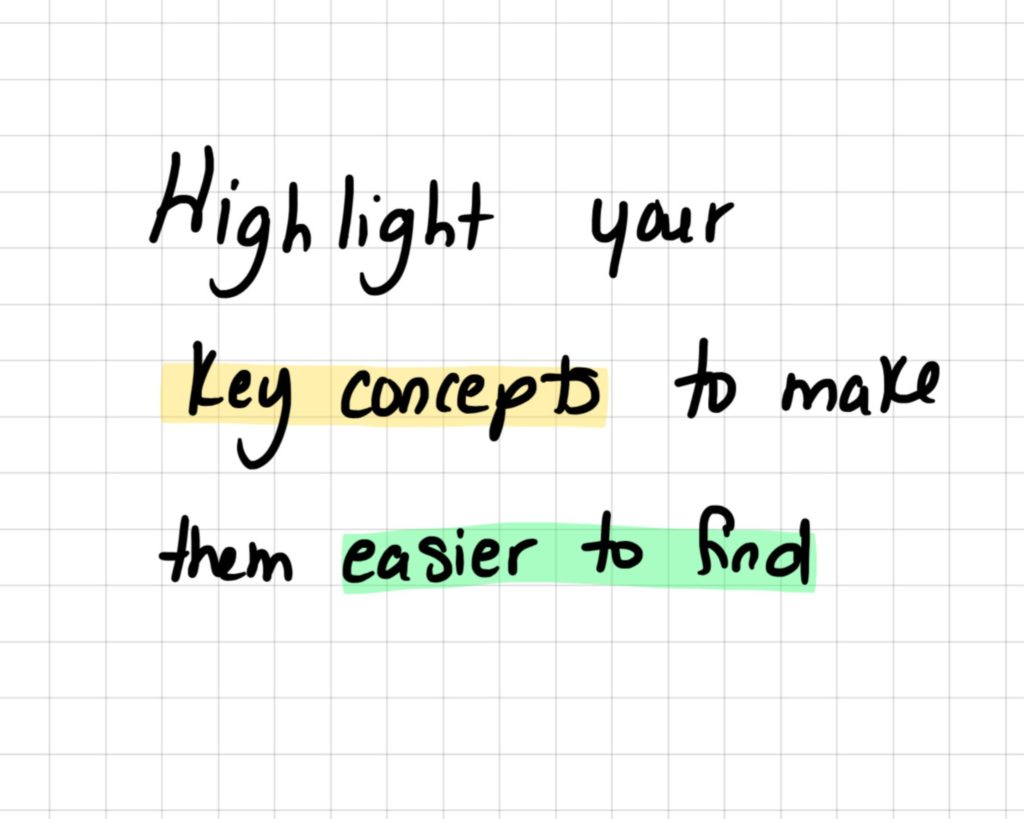
2. Highlight Key Concepts
Now, let’s talk colors.
Using different colors to highlight main ideas and important details in your notes isn’t just about making them pretty – it’s a powerful tool to enhance your learning. Assign different colors to different types of information.
For example, use yellow for key terms, blue for important dates, and pink for critical concepts. This not only makes your notes visually engaging but also helps your brain in categorizing and recalling information.
It’s like setting up a color-coded filing system in your mind. When you review your notes, your eyes will naturally be drawn to the highlighted parts, making revision sessions more efficient. This technique also helps in quickly identifying themes and patterns in your study material.
So grab those highlighters and turn your notes into a rainbow of knowledge!

3. Create Mind Maps
Mind maps are not just weirdly-laid out notes, they’re brain-friendly diagrams that mimic the way our brains think. If you’re a visual learner this is a GREAT trick to help you remember.
To create a mind map, start with a central idea in the middle of the page and draw branches that represent related concepts. Each branch can have its own sub-branches for more specific details. This method is particularly useful for understanding complex topics, making connections between ideas, and generating new thoughts.
It’s like putting together a puzzle – each piece connects to create a bigger picture. Mind maps can be especially helpful for brainstorming before writing essays or understanding the overarching themes of a course. They’re a creative and dynamic way to engage with your material, making study sessions more interesting and effective.
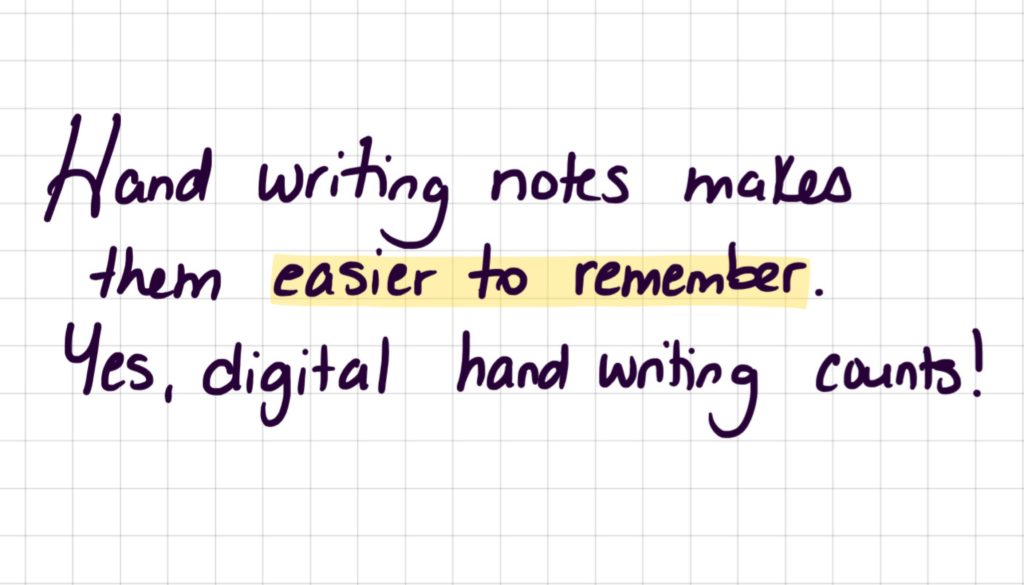
4. Handwrite Your Notes
I’m not going to lie, typing notes really does seem more quick and convenient. But writing by hand truly has unique benefits. Research shows that taking notes by hand improves both comprehension and retention.
The act of writing engages the brain in a deeper way, helping to solidify the learning. When you write notes by hand, you’re more likely to process the information and summarize it in your own words, which is a crucial part of learning. It’s also a great way to avoid the distractions of digital devices.
So, even though it might be tempting to type out your notes, try reaching for a pen and paper instead. It’s like taking the scenic route in learning – it might take a bit longer, but the views (and results) are worth it.
Fear not, you can totally take digital notes by hand these days!
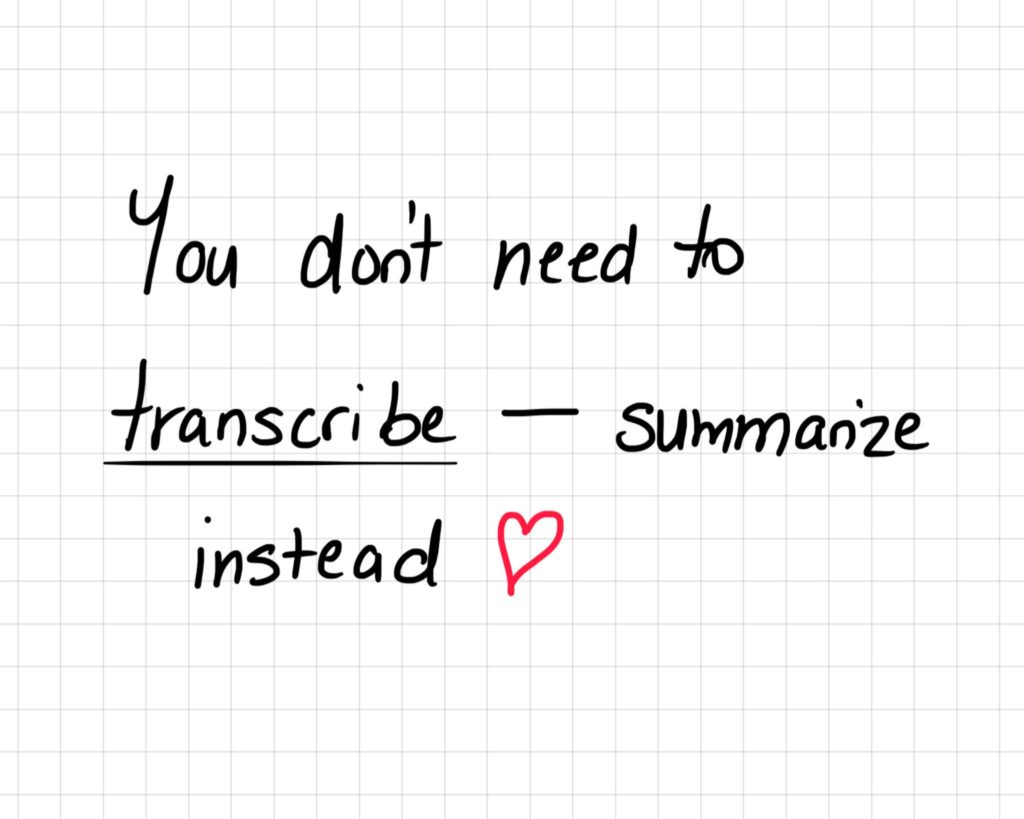
5. Summarize, Don’t Transcribe
It’s tempting to write down every word your professor says, but effective note-taking is more about quality than quantity. Focus on summarizing the key points.
When you actively listen and then summarize, you’re processing the information, not just recording it. This helps you understand and remember the material better. Think of your professor’s lecture as a movie and your notes as the trailer – they should capture the main themes and highlights, not the entire script.
This approach forces you to engage with the material, pick out the most important information, and put it into your own words. Summarizing also makes for quicker and more effective revision later, as you won’t be wading through pages of unnecessary details.
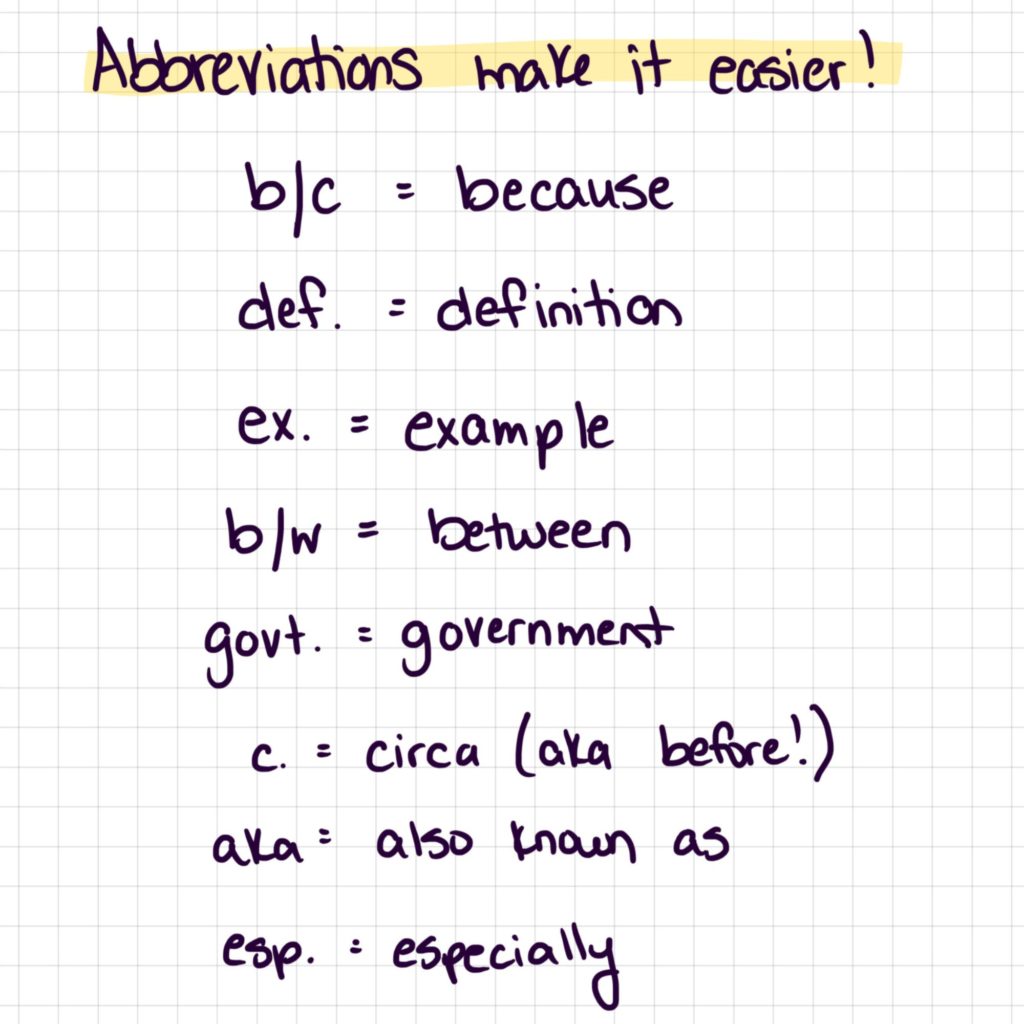
6. Use Abbreviations
Developing your own system of abbreviations and symbols can be a real time-saver. It’s like creating your own secret code that only you need to understand.
This technique is particularly useful for capturing key points quickly and keeping up with fast-paced lectures. Start by abbreviating common words used in your courses. For instance, ‘b/c’ for ‘because’, ‘ex’ for ‘example’, or ‘def’ for ‘definition’. You can also create symbols for frequently occurring terms or concepts.
The key is consistency – make sure you use the same abbreviations and symbols throughout your notes so you can easily understand them later. With a bit of practice, you’ll find that this method not only speeds up your note-taking but also makes the review process more efficient.
7. Ask Questions
Jotting down questions that arise during lectures can be incredibly beneficial. It’s an active form of learning where you’re not just passively absorbing information, but also engaging with it critically.
These questions can be clarifications of something you didn’t fully understand, or they could extend the topic further, exploring areas that intrigue you. This habit encourages a deeper understanding of the subject matter and keeps your mind actively involved in the learning process.
Plus, these questions can be great discussion points during office hours or study groups, allowing you to delve deeper into the subject. So, don’t just be a note-taker, be a question-maker. Your curiosity will lead you to a richer understanding and a more engaging educational experience.

8. Review and Revise
Think of your notes not just as a record of what you’ve learned, but as a living document that grows and improves over time. Regularly reviewing and revising your notes is like giving your brain a workout, strengthening your memory and understanding of the material.
Set aside time each week to go over your notes. During this review, look for areas that are unclear and clarify them, either through additional research or by asking questions in class. You can also condense notes further or reorganize them to make the information more coherent.
This ongoing process helps move information from short-term to long-term memory, making it easier to recall when you need it most — like during an exam. Plus, regularly interacting with your notes keeps the material fresh in your mind, reducing the need for last-minute cramming.
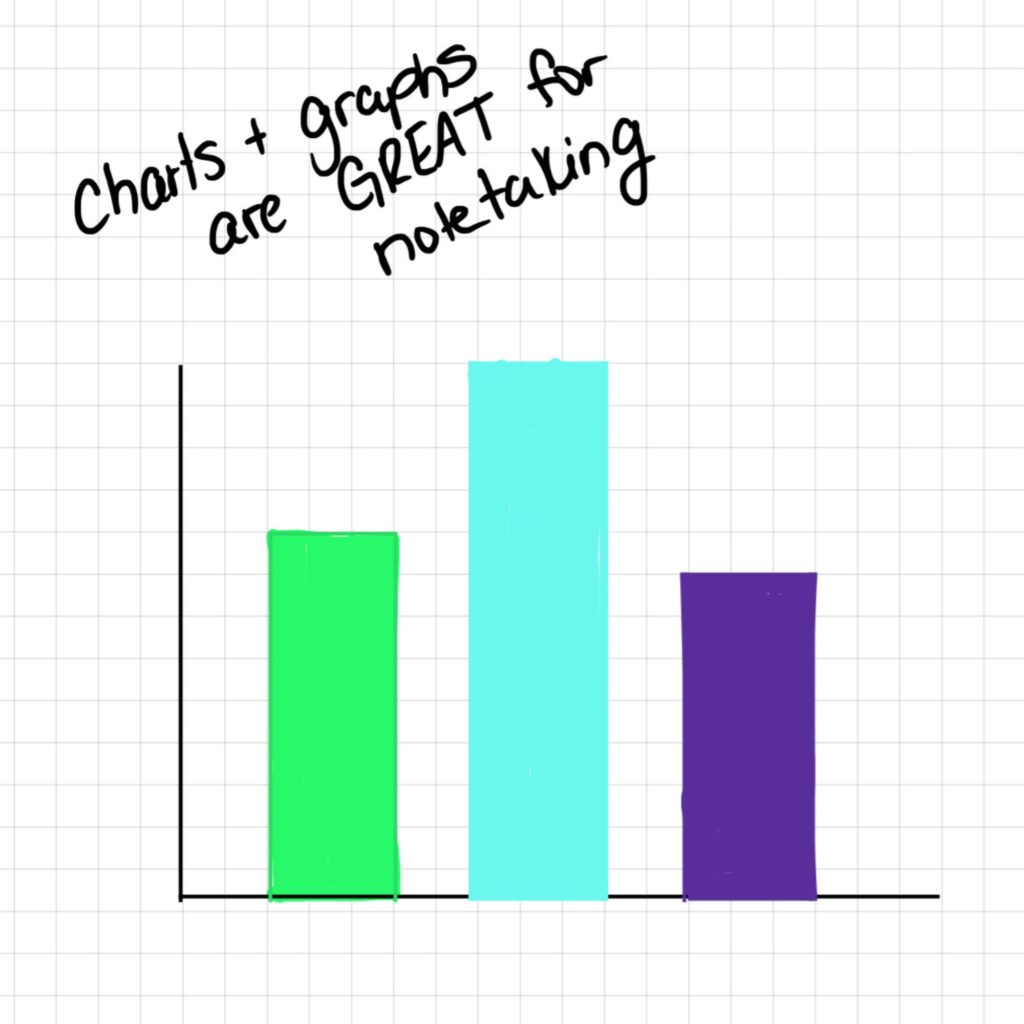
9. Use Diagrams and Charts
When you’re faced with complex information, words alone might not do the trick. This is where diagrams, graphs and charts come in. They are like the visual seasoning to the meaty content of your notes.
Diagrams can illustrate processes and relationships, turning abstract concepts into something concrete and understandable. Charts are great for summarizing data, showing trends, and making comparisons. When you create or incorporate these visual aids into your notes, you engage different parts of your brain, which helps in better understanding and remembering the information.
Ultimately, a quick glance at a diagram or chart can often remind you of the larger concept it represents. So, when your textbook or professor presents information that can be visualized, take the extra step to create that visual representation. It’s a fun and effective way to deepen your learning.

10. Stay Organized
Keeping your notes organized is like keeping your workspace tidy — it sets you up for success.
Dedicate a separate notebook or folder for each subject or topic. This compartmentalization makes it easier to find the information you need when you need it. Consider color-coding or labeling your notebooks and folders for even quicker access.
Organization also extends to how you structure the content within your notes. Consistently using headings, subheadings, bullet points, and other organizational strategies makes your notes more navigable and comprehensible.
Remember, the goal is to make your study sessions as smooth and efficient as possible. A little organization goes a long way in achieving that.

11. Record Lectures
Recording lectures (with your professor’s permission, of course) can be a game-changer. It’s like having a personal replay button for your classes.
This is especially helpful for complex topics, fast-paced lectures, or just on days when you’re not at your best. When you review the recording, you can pause, rewind, and replay parts that you didn’t understand the first time around.
This allows you to take notes at your own pace, ensuring that you capture the important information. And listening to the lecture again can reinforce your learning and provide a more comprehensive understanding of the subject. Just make sure to stay actively engaged during the lecture and not rely solely on the recording.

12. Practice Active Listening
Active listening in class is like being a detective on a mission to uncover the most important information. It involves fully concentrating, understanding, responding, and then remembering what is being said. Here are a few tips:
- Focus on the speaker and try to minimize distractions
- Engage with the material by thinking critically about what’s being said
- Make connections to what you already know
- Take brief notes to capture key points, but don’t let note-taking distract you from listening
- If something isn’t clear, don’t hesitate to ask for clarification either during or after the lecture
By practicing active listening, you’re not just hearing the words, you’re immersing yourself in the learning process.
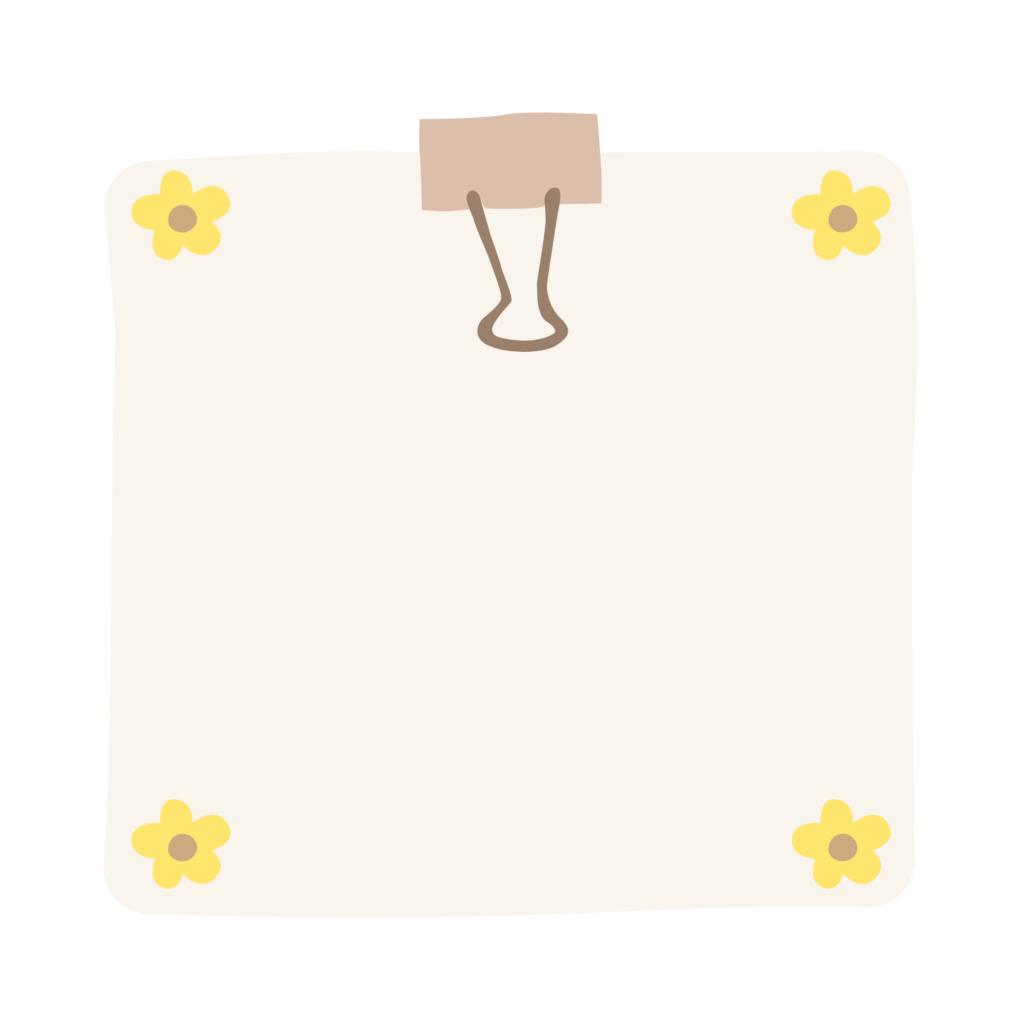
13. Use Sticky Notes
Sticky notes are the unsung heroes of effective studying. They’re perfect for adding quick thoughts, questions, or additional information to your notes without cluttering them. You can also use them to mark important pages or sections in your textbooks.
They add an interactive element to your study materials, making it easier to stay engaged with the content. Plus, the act of physically sticking a note on a page can help reinforce the information in your mind.
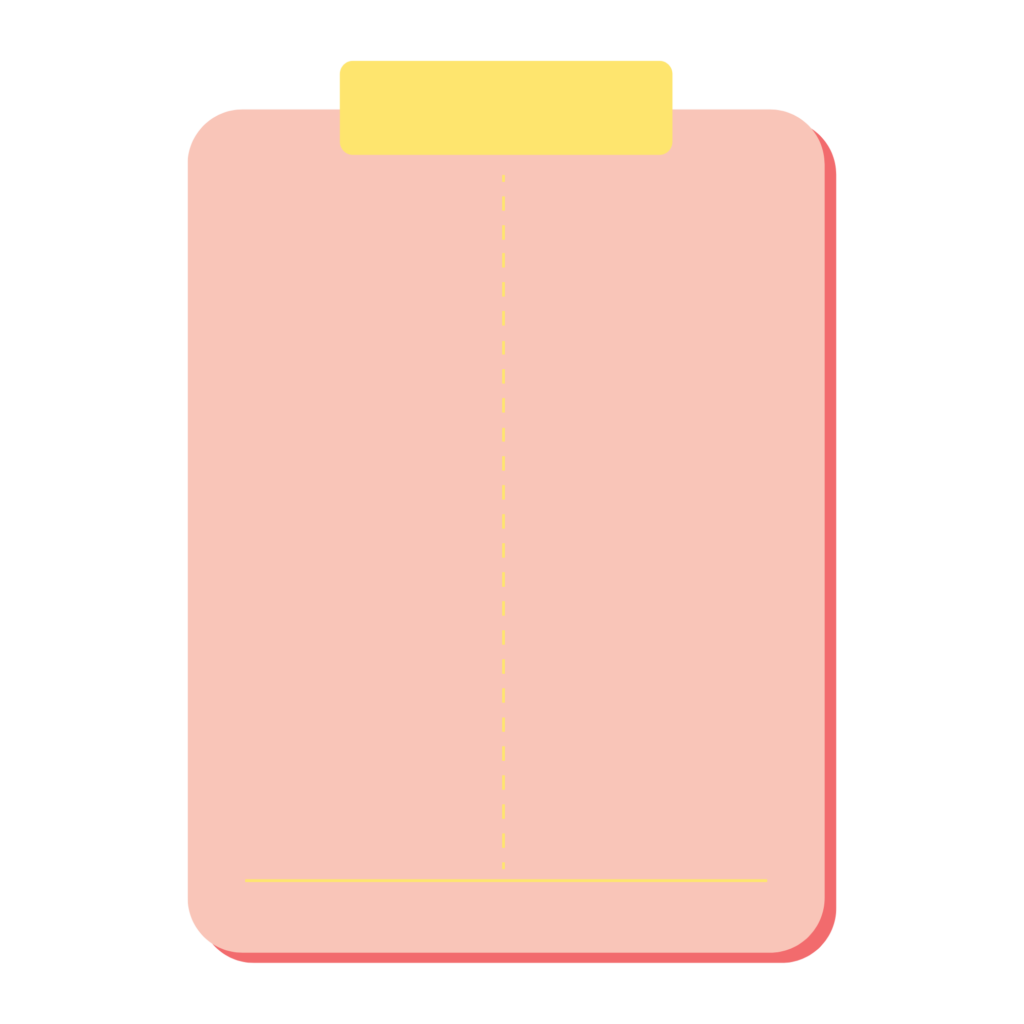
14. Compare Notes with Peers
Sharing notes with your classmates is like combining pieces of a puzzle. Everyone has their own way of interpreting and recording information, so comparing notes can provide you with a more rounded understanding of the material.
You might find that your peers have noted down information you missed or explained a concept in a way that makes more sense to you. This collaboration can fill in gaps in your own notes and offer new perspectives.
Just be sure to approach these exchanges with an open mind and the willingness to learn from others—you are not the smartest person in the room, and that’s 100% OK!
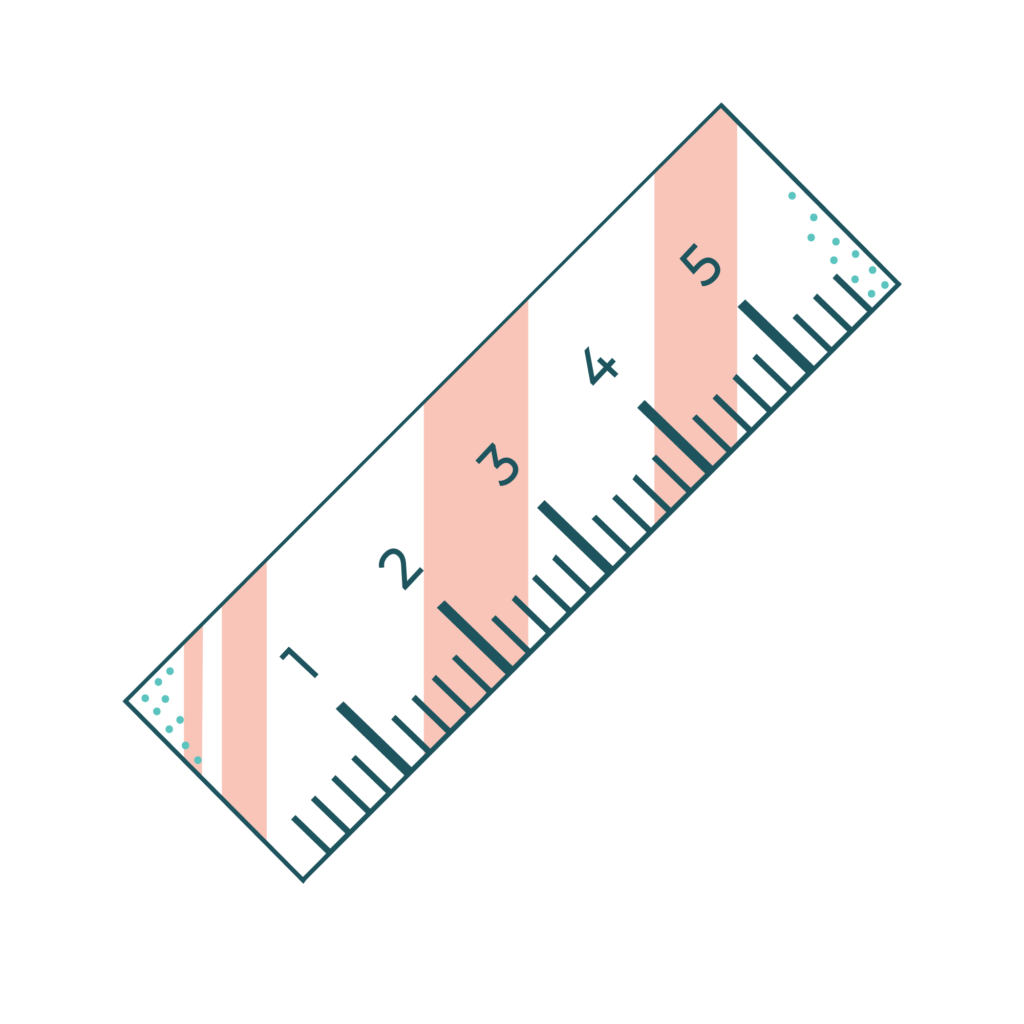
15. Leave Space for Later Additions
When taking notes, leave some empty space — margins or gaps between sections — for later additions. Think of these spaces as ‘parking spots’ for future insights.
As you continue to study and attend more lectures, you’ll inevitably come across additional information or clarifications that relate to your earlier notes. Having space to add these in the relevant sections keeps your notes up-to-date and comprehensive.
Plus, it’s a great way to connect new learning with what you’ve already noted, deepening your understanding and retention of the material. Embrace the whitespace in your notes, it’s valuable real estate for your future learning!

16. Incorporate Real-World Examples
Bringing theories to life with real-world examples is like adding spices to a meal – it enhances understanding and makes learning more enjoyable. When you connect abstract concepts to practical situations, you’re not just memorizing, you’re comprehending how these ideas function in the real world.
For instance, if you’re studying economics, look at how supply and demand play out in everyday market scenarios. If it’s psychology, observe behaviors in real-life situations that reflect psychological theories. This approach makes the material more relatable and memorable.
Ultimately this way of thinking prepares you for applying these concepts in your future career. Next time you’re buried in theories, step back and ask, “Where do I see this in real life?” It’s a simple question that opens up a world of understanding.

17. Utilize Online Resources
In today’s digital age, the internet is a treasure trove of learning resources.
Supplementing your notes with online lectures, tutorials, and articles can give you a more comprehensive understanding of the subject matter. Websites like Khan Academy, Coursera, or even YouTube educational channels provide explanations that might resonate with you differently than your textbook or lecture notes.
Many academic journals and articles are also available online, offering deeper insights into specific topics. But here’s a pro tip: always ensure the sources are credible. Learning from a wide range of resources not only broadens your perspective but also equips you with different ways of understanding and explaining concepts.
This varied approach to learning keeps things fresh and engaging, preventing study fatigue.

18. Teach What You’ve Learned
They say the best way to learn is to teach, and it’s true. When you try to explain a concept to someone else, you’re forced to understand it well enough to communicate it clearly. This process often reveals gaps in your own understanding, prompting you to learn more deeply.
Start a study group where each member teaches a different part of the course material, or just explain a new concept to a friend or family member. Don’t worry about their background knowledge, simplifying complex topics is a great way to solidify your own understanding.
This technique not only reinforces your learning but also improves your communication skills, a valuable asset in both academic and professional settings.
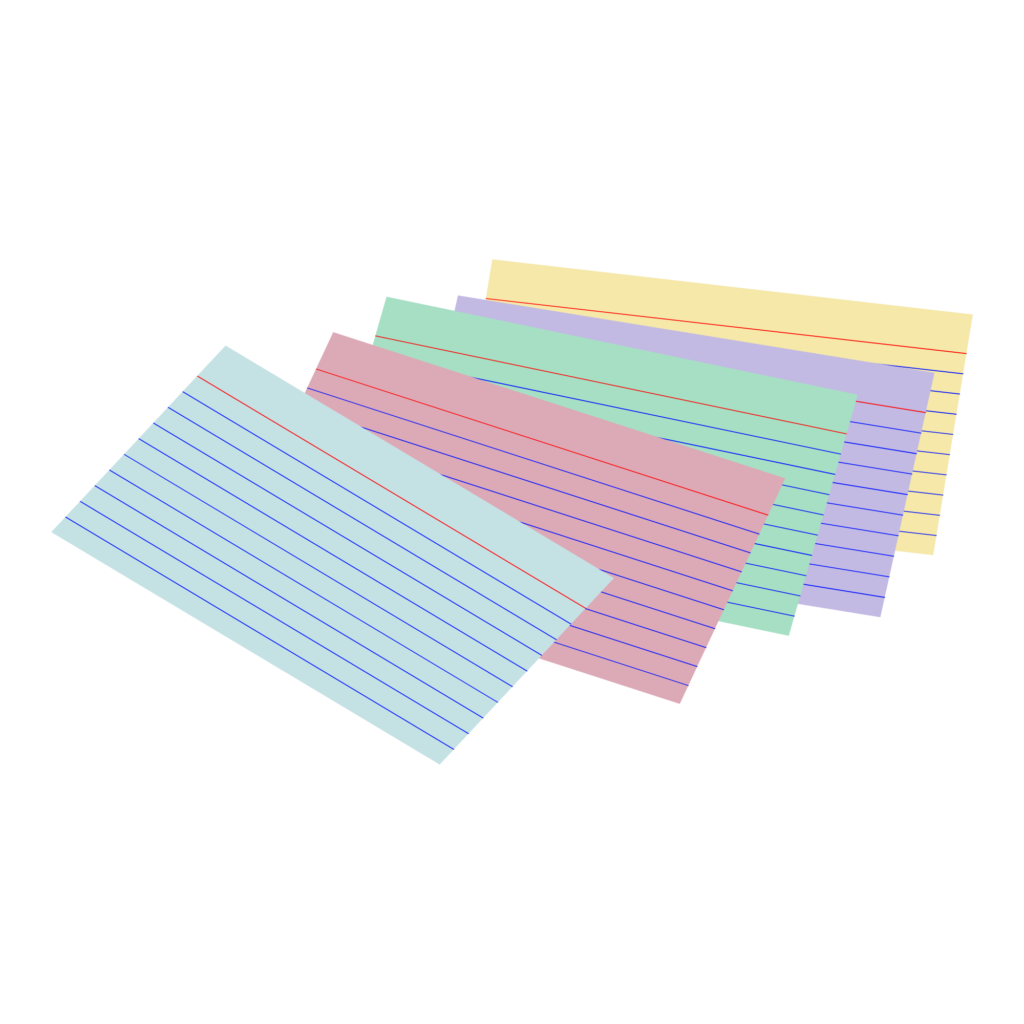
19. Create Flashcards
Flashcards are a classic tool for good reason. They’re portable, versatile, and perfect for quick revision sessions. On one side, write a key term or question, on the other, the definition or answer.
This method engages active recall, a powerful memory technique where you practice bringing information to mind without seeing it first. Test yourself regularly with these cards — during a commute, between classes, or while waiting in line.
Over time, you’ll find that the answers come to you more quickly and easily, greatly improving your retention of the material. Plus, creating the flashcards is a study session in itself, as you’re processing and summarizing information while you make them.
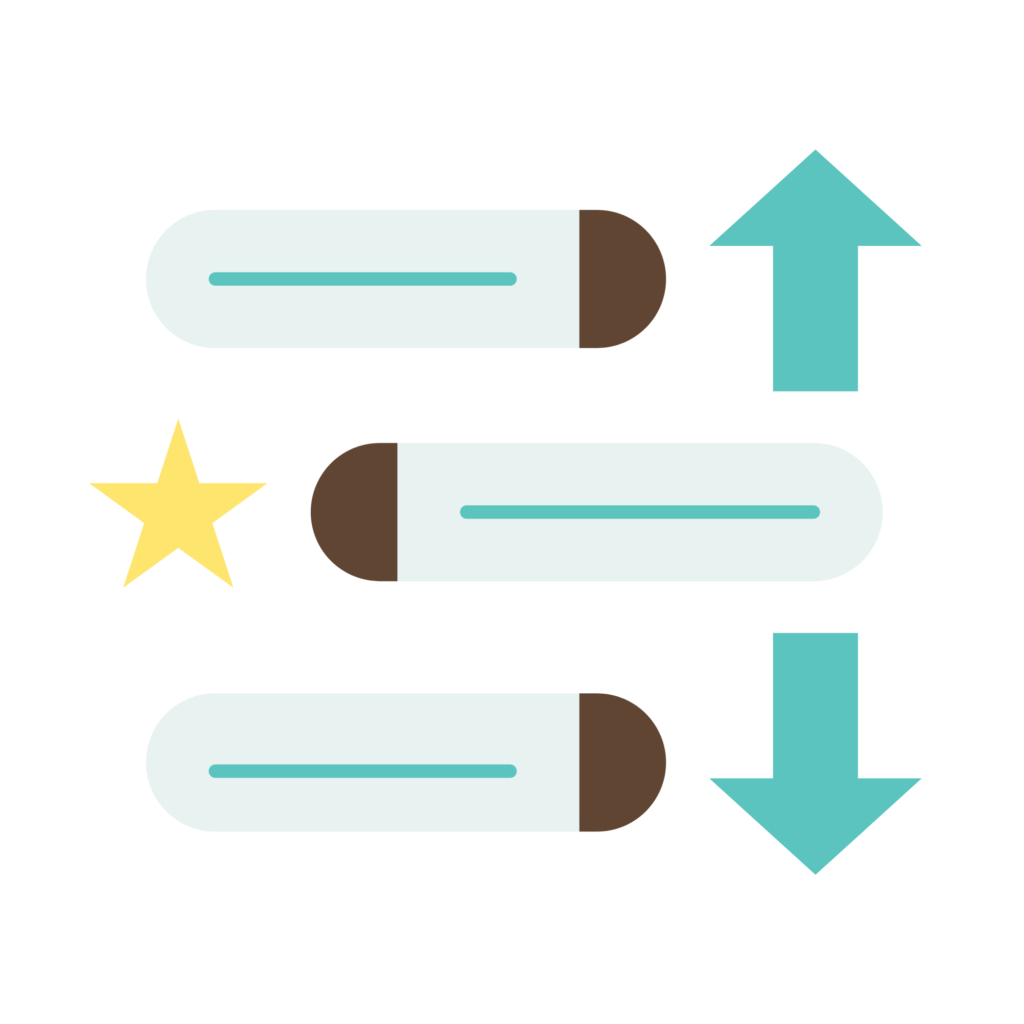
20. Prioritize Information
Not all information is created equal, especially when it comes to studying. Learning to prioritize information helps you focus on what’s most important, making your study sessions more efficient. Start by identifying the core concepts and key themes of your course.
Look for clues in your syllabus, textbooks, and lecture emphasis to understand what your instructor deems most important. Prioritizing doesn’t mean ignoring less important topics, it’s about allocating your time and effort strategically. This approach helps in managing the overwhelming amount of information and ensures that you cover the most critical material thoroughly.
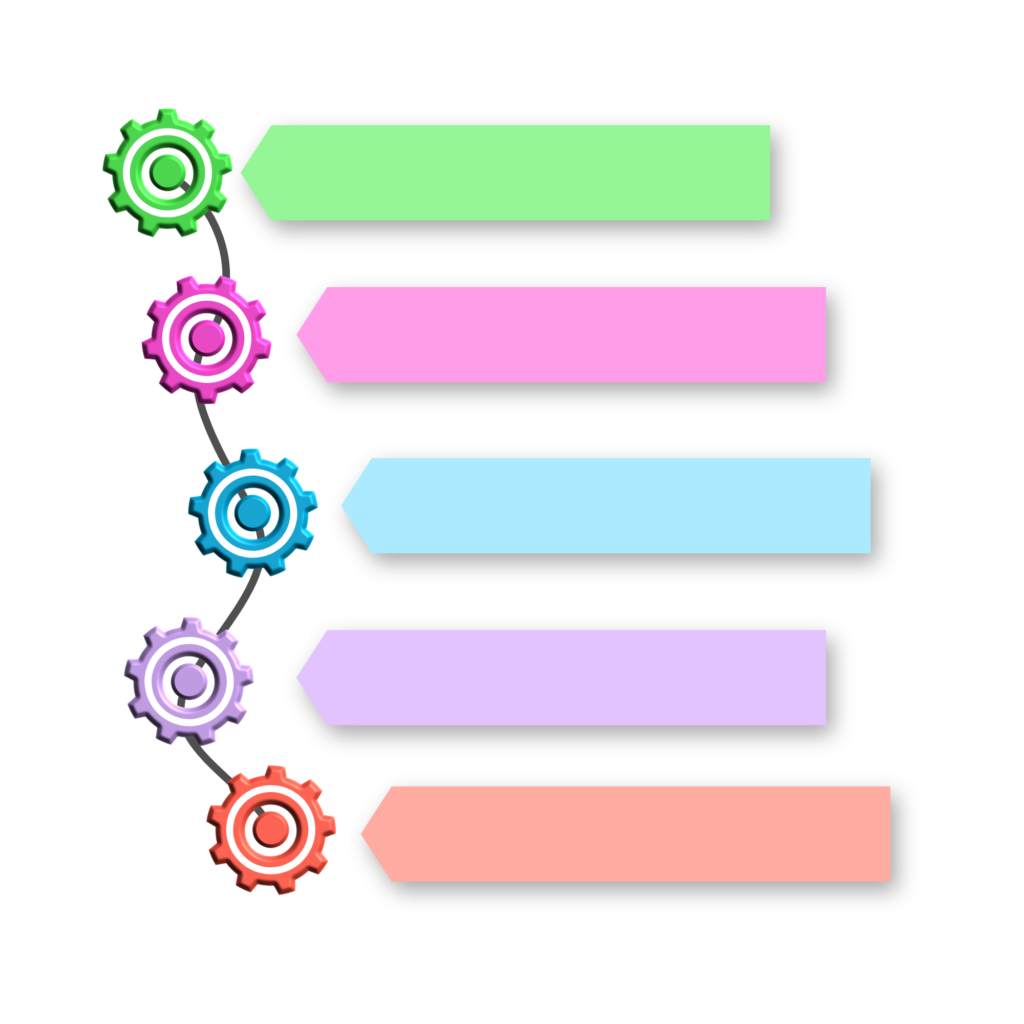
21. Break Down Complex Topics
Tackling complex topics head-on can be daunting. Breaking them down into smaller, manageable parts makes these topics less intimidating and easier to understand. It’s like eating a pizza slice by slice instead of trying to eat it all at once.
Start by identifying the main components of the topic. Then, study each component individually before connecting them back into the bigger picture. This method allows you to focus on one aspect at a time, reducing confusion and making the learning process more digestible. As you gradually piece together the smaller parts, the overall concept becomes clearer and more coherent.
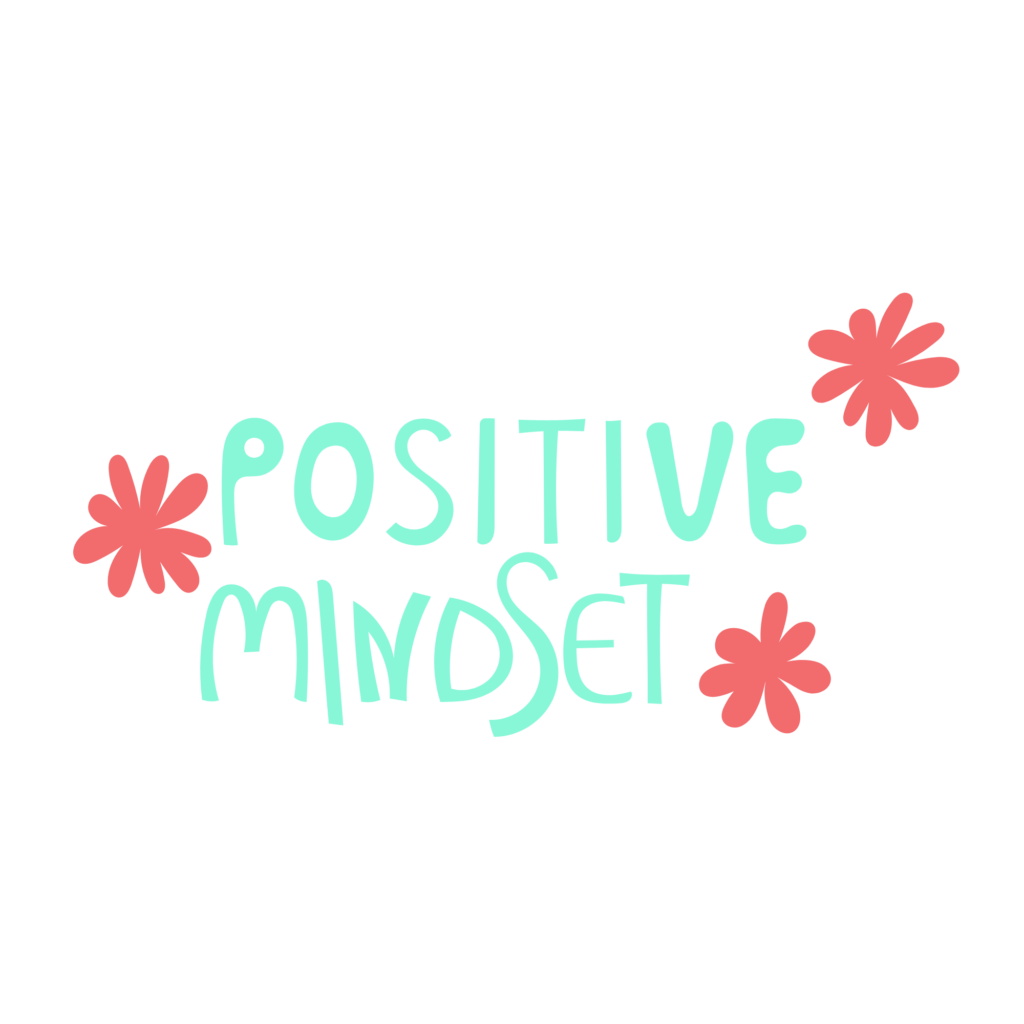
22. Stay Positive and Motivated
Maintaining a positive attitude towards studying and note-taking can dramatically impact your learning experience. It’s about embracing the journey, not just the destination (grades).
Set realistic goals, celebrate small victories, and remember that progress is incremental. Find study methods that work best for you and make the process enjoyable — maybe it’s studying in a cozy cafe, or with a study group, or using colorful stationery for your notes.
When you hit a rough patch, remind yourself of your goals and the satisfaction that comes with achieving them. Staying positive and motivated is a strategic approach to learning that can lead to better outcomes and a more fulfilling educational experience.

23. Connect the Dots
One powerful tip for note taking is to actively connect new information with what you already know. When you’re jotting down notes, pause and think about how this new piece of knowledge ties in with previous lectures, your own experiences, or even real-world events.
This approach helps in creating a web of understanding, where each new fact or concept is a thread linked to a larger tapestry of knowledge. By drawing these connections, you’re not just memorizing; you’re constructing a deeper, more integrated understanding of the subject matter. This makes recall easier and learning more meaningful.
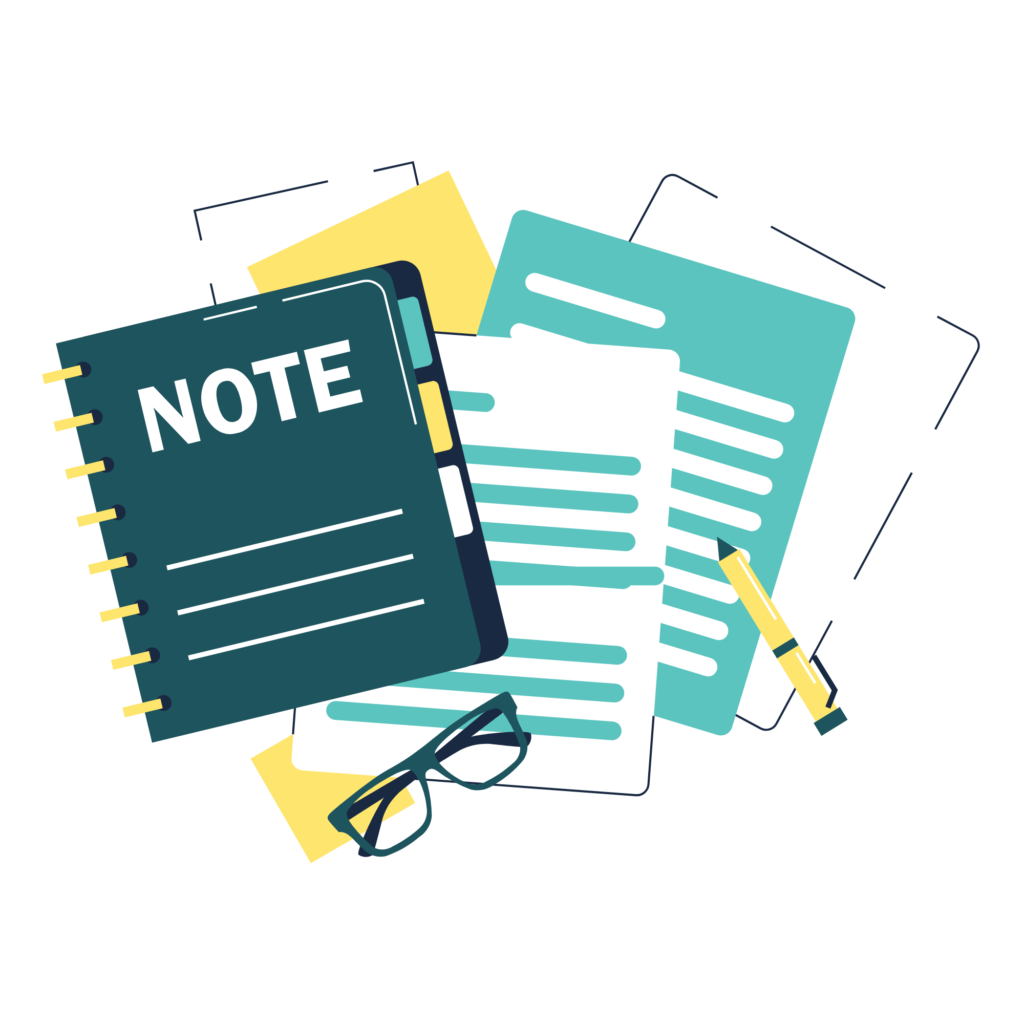
24. Teach Through Your Notes
Another effective strategy is to write your notes as if you’re going to teach the material to someone else. This doesn’t mean you have to actually teach it, but adopting this mindset encourages you to organize your notes in a clear, logical, and concise manner.
When you take notes with the intention of teaching, you naturally simplify complex ideas and focus on the most important points. This process not only helps solidify your own understanding but also ensures your notes are as useful and accessible as possible.
It’s also a great way to prepare for group study sessions or discussions, as you’ll have your material organized in a teachable format!
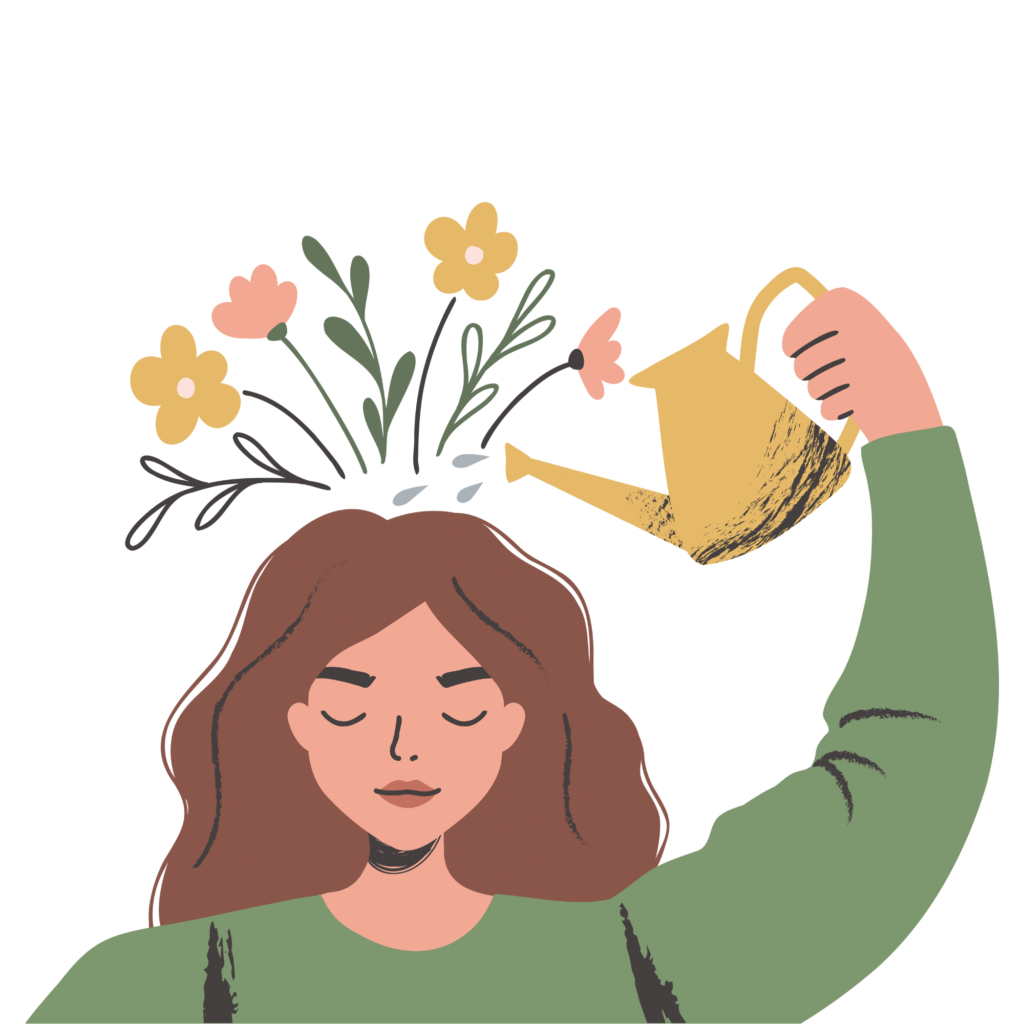
25. Incorporate Your Own Thoughts and Interpretations
Don’t hesitate to add your own thoughts, interpretations, or reactions to the material when you’re taking notes. This personal touch turns your notes from a mere recording of facts into a reflection of your learning process.
For example, if you’re studying a historical event, jot down how it impacts your understanding of the present. If it’s a scientific concept, write about its implications in real-life scenarios. Including your perspective not only makes the notes more engaging but also encourages a deeper level of thinking and understanding.

26. Use Mnemonic Devices
Mnemonic devices are creative ways to remember information by associating it with familiar images, patterns, or words. This could be as simple as an acronym where each letter stands for a part of the concept you’re trying to remember, or a rhyme or song that helps cement the information in your memory.
For instance, many students remember the colors of the rainbow with the acronym ROYGBIV (Red, Orange, Yellow, Green, Blue, Indigo, Violet). Creating these devices can make study sessions more fun and effective.
The more unique and amusing the mnemonic, the more likely it is to stick in your mind. So, get creative with your notes and transform those tricky bits of information into memorable snippets.
Final Thoughts: Tips for Note Taking
By embracing these tips for note taking, you’re not just improving your ability to capture information, but also enhancing your overall learning experience. The power of effective note-taking extends beyond just remembering facts for exams, it’s about deeply understanding and engaging with the material.
I hope you feel inspired and equipped to tackle your next lecture or study session with newfound confidence and skill. Keep these tips for note taking in your back pocket, and watch as they open doors to a more organized, efficient, and successful academic journey.